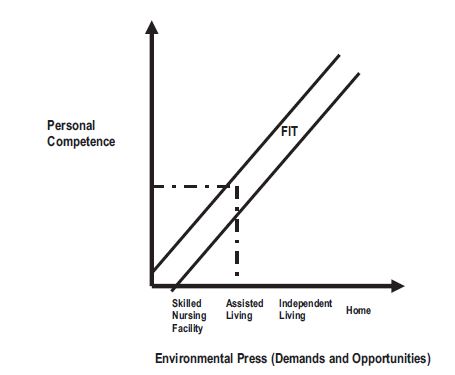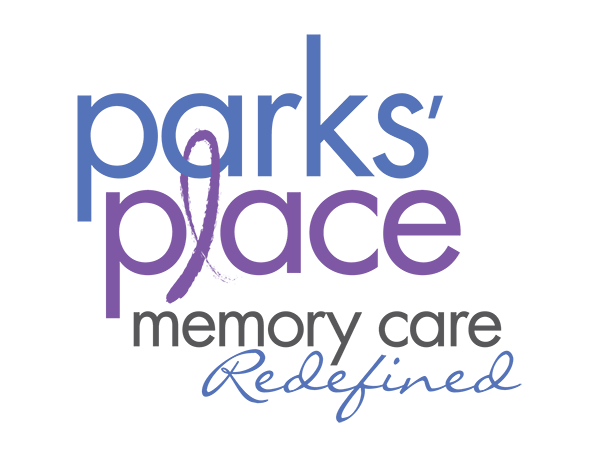As it becomes apparent that your loved one needs extra support in his or her daily life, it can be difficult to know the necessary type of support. There is a large continuum of care available to elders with many more options than 50 years ago. So, how do you know what type of care fits your loved ones needs? How can the care adapt as your loved one’s needs change?
First, let’s take a look at two models used to inform care and when a move or transition is needed: the Person-Environment Fit Model (P-E Fit) and Transitions Theory. These are models used in the gerontological field to help determine care settings.
Person-Environment Fit Model (P-E Fit)
The P-E Fit Model provides insight into the person and environmental factors that influence health outcomes, in other words, it is focused on the relationship between the person and the environment he or she is living in. Below is a graphic description of this model. The y-axis is personal competence; this is the health, cognition, motor skills, and sensory perception of the individual; in other words, their physical and cognitive abilities. The x-axis is the environmental press, meaning the demands the environment places upon the person living there. Think of the demands of the environment as the tasks that need to be completed to live in that environment, such as household chores, home maintenance, shopping, cleaning, etc. and the personal tasks like managing medications, eating, toileting, grooming, bathing, dressing, etc. Basically, the higher the environmental press, the higher the personal competence needed to live in that environment.
The area where personal competence and environmental press meet is depicted as a band. If the elder falls within this band, he or she would be “in fit”, meaning his or her abilities align with the demands of the environment. If the elder does not fall within the band, he or she would be “out of fit”, meaning their personal abilities do not align with the demands of their environment. If someone is out of fit, they cannot safely live in that environment and two things can happen: the environment can be adapted or there can be changes to the personal competence through another person supporting him or her.

How does the environment adapt? It can adapt in multiple ways. The place of living can be simplified physically by eliminating trip hazards, putting everything needed on one level, eliminating clutter or too many items, etc. Or, the environment can be changed by moving to an assisted living, memory care, skilled nursing facility, etc. based on the needs of that individual. By changing the environment to a level that matches the personal competence, the person can thrive in fit.
How can personal competence adapt? To expect that a person with dementia will adapt to meet the demands of environmental press is unrealistic. But, that does not mean that someone else cannot bridge that gap. If the person with dementia is living at home or in independent living, a family member or hired in-home care could provide the competence needed. If the person with dementia is in assisted living, the care staff may bridge the gap. But, there will come a time when the needs of the person with dementia will outgrow what the assisted living can provide.
Transitions Theory
In Transitions Theory, a transition occurs when the individual’s established behavior patterns are no longer adequate for the demands of the situation and the assumptions about oneself or the world are challenged. The transition is subjective to each individual to the recognition of change, meaning a transition happens when the person can perceive there is a change happening. Commonly occurring transitions later in life include relocation, changes in health or function, loss of relationships, and role changes. A transition can trigger another transition, for example, loss of function can trigger a need for relocation, which can cause disorientation.
Memory Care or Assisted Living?
Now let us circle back to making a decision between a memory care or an assisted living. Using what we know about P-E Fit and Transitions Theory can help us make a decision. No one is a fortuneteller who can predict the future, but you are able to make educated choices to help reduce rocky changes.
It is important to understand the services available in each setting, how the services can grow with the resident, and any limitations in services. Let’s take a look at the average assisted living and the average memory care home in the chart below, please note this is not an exhaustive list.
| Assisted Living | Memory care | |
| Available Services | Environmental support (i.e. Housekeeping and laundry). Assistance with ADLs. Simple physical environment. Signage for cuing. Visible staff. Structured social activities. Health monitoring. | Environmental support (i.e. Housekeeping and laundry). Assistance with ADLs. Simple physical environment. Signage for cuing. Visible staff. Structured social activities. Health monitoring. Managing symptoms of dementia. Specialized activities for people with dementia. Dementia specific staff training. Secured entry. |
| Limitations | Managing symptoms of dementia past early stage. Specialized activities for people with dementia. Health condition that requires 24 hour monitoring by a nurse. Managing behavioral symptoms. | Health condition that requires 24 hour monitoring by a nurse. Unsafe behavioral symptoms by residents. |
How do you know what is right for you? We are not able to answer that for you, but you can apply this information to the unique situation of your loved one and his or her needs. You can assess the needs, personal competence, environmental press, and transitions and make an informed decision for or with your loved one.
What Can Parks’ Place Memory Care Provide?
Park’s Place provides all the items listed under the average memory care and much, much more. So what sets us apart? Using both P-E Fit Model and Transitions Theory, three major ways to assist residents are to improve personal competence, bolster the environment, support transitions, or a combination of all three. Which is exactly what we do.
Improve Personal Competence. As stated earlier in this blog, it is an unrealistic expectation that someone living with dementia will be able to improve his or her personal competence. If you are searching for a memory care for your loved one, he or she passed the point of being able to adapt their personal competence. But, our staff is able to bridge the gap so their personal competence meets the environmental press. For example, we provide assistance for any and all cares from a simple verbal cue to full hands-on assist. We are able to meet the needs of the resident wherever he or she is in their dementia journey and expand cares as time goes on.
Additionally, our specialized activity program is designed to be a form of treatment for dementia, not just something for the residents to pass the time. The activity program helps to orient the residents to the time of day and works within their abilities so that they feel a sense of purpose and productivity. Because the activity program works within the ability of the residents, it matches their personal competence. We will also look at activities while discussing transitions.
Bolster the Environment. Our home was designed for the person living with dementia. It is single level with a simple, flowing footprint to allow for residents to safely walk or wander without getting lost. We are barrier free so residents do not feel a sense of confinement. Our main area has all the elements of a regular home, including a kitchen, living room, TV room, and a sunroom. It is designed to make you feel at home and not in an institution. This helps to reduce the feeling of living in a facility to just moving to a new home, therefore reducing the sense of change for the resident. Additionally, the overall design and services we provide reduce environmental press for the resident and allows residents to live in fit.
Support Transitions. As we learned, transitions are not only environmental transitions like moving to a new home, but also cognitive, physical, and emotional. The environmental transition of moving to a new home will vary from person to person, for some it may be a big change, for others not so much. Our home is for people of all stages of dementia so they will only need to move once, and experience that transition once, during their dementia journey. Cognitively, as people transition from one stage to the next, we are able to meet them where they are and adjust the cares, communication, and activities as necessary. Physically, people with dementia will need more assistance as they progress. They may go from walking and transferring unassisted to needing a one-person assist, to a two-person assist, to needing a mechanical lift. Changes in physical ability will also affect other areas such as lifting their arms to wash their body in the shower to lifting eating utensils. We are able to support our residents during each one of these transitions by increasing the hands-on level of care. Emotionally, as people age they will begin to lose relationships and friends as the resident is no longer able to recognize friends and family members or those close to them pass away. Our staff provides emotional support in a variety of ways, by gently reminding residents who their visitors are, providing friendship, and by being a kind, trusted person to provide cares. We also can design activities or have activities available for residents that are reminiscent or purposeful for them. These types of activities help to smooth transitions by reducing the perception of a change for the person with dementia.
To learn more about Parks’ Place and how we can support your loved one, call Kaitlin at 612-358-3725 or email her at Kaitlin.kelly@parksplacememorycare.com.
The source used for this blog post can be found here.
Parks’ Place Memory Care is a privately owned assisted living home, specialized and specifically designed for those with Alzheimer’s and other dementias. Our home is for people of any stage of dementia so they are able to age-in-place in their home. For tours, general information, or admission inquiry, please contact Kaitlin Kelly at 612-358-3725.


